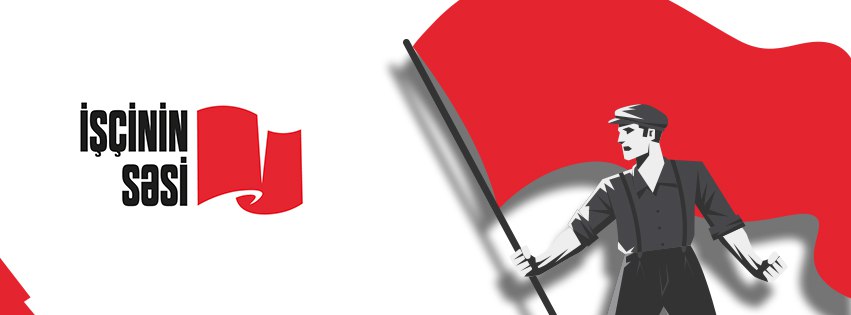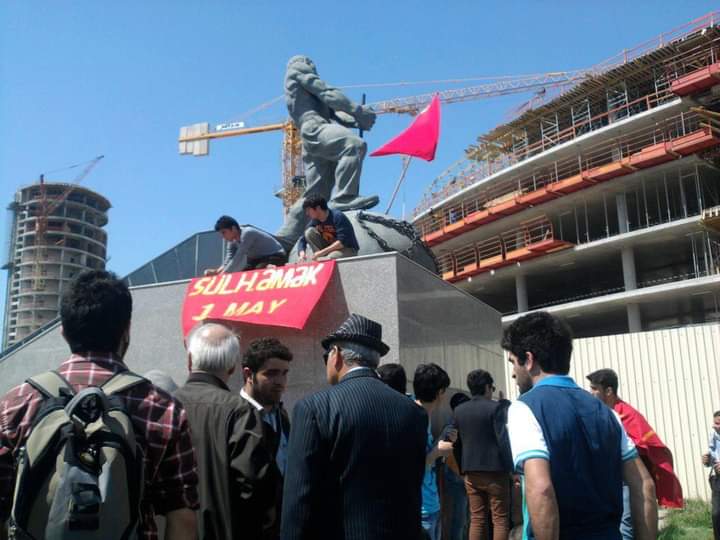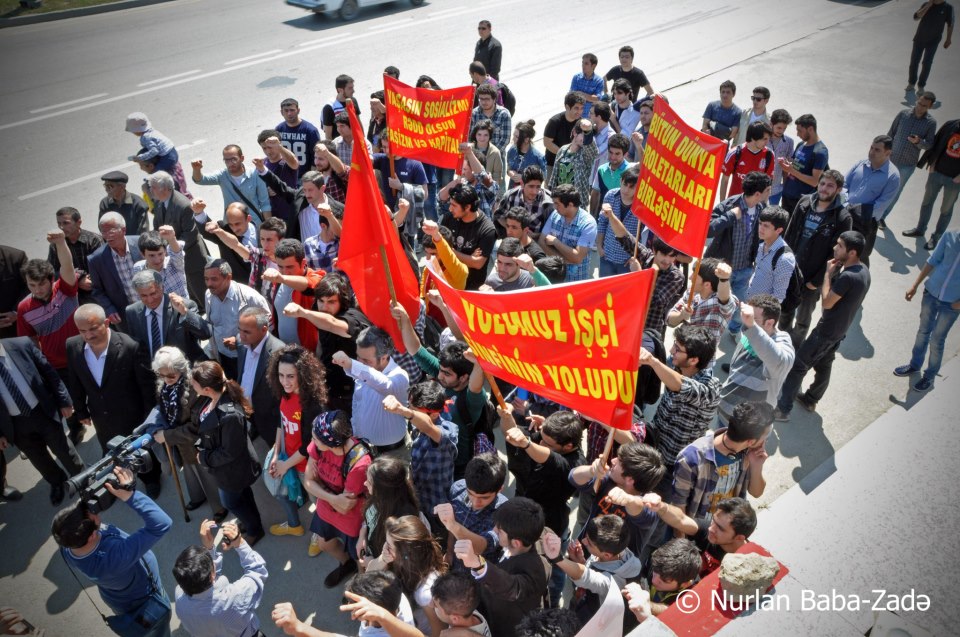
LeftEast editors met our Azerbaijani comrades at LevFem’s / Transnational Social Strike’s conference in September 2022 in Sofia. As we knew almost nothing of the left in that country, we asked them for an interview, and they generously obliged.
LE: Could you introduce yourselves: who are you and what are you fighting for?
We are The Worker’s Voice (İşçinin Səsi) collective. The Worker’s Voice is a socialist media outlet that aims to break the bourgeois monopoly over media in Azerbaijan. Media outlets in our country are overwhelmingly financed by two sources, either by the authorities, or by Western funds. Accordingly, media express only the views of the ruling elite and liberals. This is the situation that we aim to change. We post news and write articles about labor in our country, labor protests, strikes, deaths and injuries in workplaces, about economic, political, and social developments in Azerbaijan and the South Caucasus, about revolutionary upheavals and socialist agenda in the international arena.
LE: Let’s start with the most difficult question, which has become inevitable since Azerbaijan’s latest attack on Armenia. What’s the relationship between the war with Armenia and the workers’/left movement in Azerbaijan?
The war with Armenia expressed several class contradictions in Azerbaijan. Firstly, it was the youth from workers and peasant classes, who made up the largest chunk of conscriptions. Military service in Azerbaijan is one of the most corrupt structures. The border region with Armenia is one of those places for military service where people from the poorest part of the population were being sent, as they could not afford sufficient bribe for the military registration office to be sent far from the border. It was the former soldiers who had completed their military service in this region who were first called for mobilization when the war started in September 2020.
Azerbaijan’s government is an authoritarian regime. Political participation has been practically banned for at least a couple decades while the Nagorno-Karabakh problem has remained the only question in which the people are free to express their (nationalist) views, which for the most part coincide with the official position of the Aliyev government. So just prior to the war, when the president Ilham Aliyev made a call for enrollment in voluntary mobilization, thousands of young men joined the queues in front of military registration offices. This “rally around the flag” was the result of years of propaganda.
Furthermore, as it was later revealed, just before starting the war, the government of Azerbaijan held secret meetings with mining companies and embassies of such countries as the United Kingdom to negotiate the division of gold mines and other natural resource fields in Nagorno-Karabakh and surrounding areas. Prior to the war, mainly Swiss and French companies were operating these fields, in agreement with Armenian and Karabakh authorities. As the war ended, these fields were opened for exploitation mostly by British, American, and Turkish companies, which also often have Aliyev’s family members as their shareholders. Consequently, it appears that thousands of Armenians died to protect the ownership of one group of imperialist capital, while thousands of Azerbaijanis died to protect the ownership of another group of imperialist capital. Suspension, redivision, and restart of exploitation of gold mines and other resourceful fields were the only processes on ground in those regions, which were taken by Azerbaijan in 44 days of war in 2020.
LE: Ok, let’s then go back to the very beginning. Azerbaijan is much less known abroad than any of its neighbors in the Caucasus so we’ll be very grateful for some background on recent labor history. What have labor rights and working conditions been like for the last thirty years? Are they very different across the different sectors (public vs. private; oil vs. non-energy-related; foreign-owned vs. domestic)? Which Soviet legacies in the realm of labor are still around?
After the collapse of the Soviet Union, as a result of heavy blows to the industrial sector in Azerbaijan (closure, demolition, and sale of factories) and, in parallel, the decrease in the level of employment in that sector, the new relationship between employers and employees and the workers’ view of the trade union have transformed the existing unions. Especially since the 1990s, the triumph of neoliberalism in the Caucasus and the changes it brought to the region’s labor market had a severe impact on trade unions. With the advent of capitalism, the problems of the working class have changed, and as a result, there has been a need for radical changes in the way trade unions operate.
According to the Confederation of Trade Unions of Azerbaijan (CTU), there are currently 27 trade unions in thousands of affiliated workplaces in the country. Although it seems to be an important figure in terms of numbers, the activity of these unions is not known to anyone. Workers feel the existence of these unions when there is a 2% deduction in their wages. It seems that when state enterprises were privatized, trade unions were also privatized. Thus, in many enterprises, the chairman of the trade union is either the company’s deputy director or his most loyal employee.
In recent years, unregistered employment in Azerbaijan has reached such a level that employment contracts were not concluded anywhere except for state enterprises. Currently, the “legalization” process takes place through changes in salaries or working hours of employees.
Another problem that narrows the sphere of influence of trade unions is the expansion of the service sector and the lack of organization there. One of the business forms that has become popular in recent years is subcontracting. While servitude is practiced in many business sectors, in recent years, it has most affected workers in the taxi and courier sectors. The fact that they are not registered as employees makes it easier for companies to fire striking workers, as it again is easier for them to find new workers from among the huge army of unemployed.
Since there are more employees in the public sector than in the private sector, there are more unions in the public sector. While this situation could be an incentive for private sector workers to form unions, “yellow unionism” certainly has a negative impact on the perceptions of unions. Therefore, trade unions have become an unreliable mechanism in the eyes of workers, failing to gain their trust.
In addition to all this, the reasons for the low number of workers organizing in trade unions are the lack of knowledge about trade unions among workers, the fear of unemployment and the difficulty of organizing new workers. No matter how discredited the trade unions are, no matter how hard it is to organize workers, sooner or later the bourgeoisie will reap what it sows. Thus, the bourgeoisie and its political representatives are unable to break the collective will of the working class, despite all prohibitions, authoritarian management systems, and propaganda. Workers with nothing left to lose finally see the need to unionize and take action. In recent years, angered by the frequent non-payment of their salaries, the workers of the state-owned oil company have staged protests demanding better working conditions and issuing other demands. In addition, let’s note that we are witnessing the massacre of workers during the reconstruction work in Karabakh. Workers operating in areas that have not been cleared of mines often fall into mines and die or get seriously injured.
Despite all this, the year 2022 will be remembered for the largest working-class protests in Azerbaijan in recent history. Couriers working for many different companies organized strikes without any external support several times, demanding higher wages and better working conditions. Although their demands were not met, it set a good example for other workers. After courier strikes we witnessed protests by construction workers, teachers, and other workers in different parts of the country.
LE: What are labor unions like in Azerbaijan? Are there any genuine, fighting organizations? Has there been serious labor unrest? If so, in what sectors of the economy do they tend to happen? What kind of demographics are at the forefront of it?
There are only “yellow unions” in Azerbaijan. In total, there are 27 trade unions, but all of them are state agency-like structures, means of the government to maintain additional control over the working class. This is precisely the reason why unions stayed out of protest movements and all forms of labor unrest were organized exclusively by the workers themselves without any support from unions. There were many episodes of labor unrest during the last three decades, but almost all of them were unsuccessful, being crushed by the police and achieving no developments in labor organizing. In recent years, construction workers and workers of subcontractor companies in the oil industry have been at the forefront of labor protests. Couriers working for food-delivery companies also moved to the center of public attention for their strikes. There were more developments in this sector, in which legally couriers are not even workers, but individual owners. However, despite such legal problems, couriers have shown remarkable capacity for demanding their rights and organizing around them.

LE: Are there political parties, official institutions, or NGOs who have been helpful in defending workers’ rights? Any other allies (social movements, groups) to Azerbaijani labor and left?
Workers’ rights is not one of those terms that political parties and NGOs would use. The only exception to this would be the Oil Workers’ Rights Protection Organization (OWRPO), as it is focused on a group of workers. The oil-gas sector makes up 90% of all exports of Azerbaijan while it employs less than 1% of all workers. Through product-sharing agreements (PSAs) signed with foreign oil companies, unionization in the oil sector is forbidden. The OWRPO documents and publicizes problems related to oil workers, corruption in the State Oil Company of Azerbaijan Republic (SOCAR), and pollution in the Caspian Sea.
By contrast, the situation of the largest part of the country’s labor force is undocumented. Rarely are protests of workers defended by politicians or NGO leaders. It is because the so-called civil society in Azerbaijan is overwhelmingly liberal and conservative and has little interest in promoting workers’ rights. The weakness of the leftists, the near-absence of the left leaves workers alone with no real political ally.
LE: What is the contemporary Azerbaijani left (most broadly and generously understood) like? Is there as big a gulf between it and the working classes and their struggles, as there is in other postsocialist countries?
The contemporary Azerbaijani left is as divided as ever. On several occasions, leftists organized collectives of different types, but none of them have survived to the present. The Azerbaijani left appears to be a sum of leftist individuals who collectively cannot overcome the problem of organizing. As they cannot organize among themselves, they do not have any influence among working classes. The left in Azerbaijan cannot express itself as a united force yet, and remains in the shadow of liberal opposition. There is no leftist political center of gravity, which would organize wage laborers as an independent social group and deal with theoretical problems concerning economical, political, and social problems of the working class in Azerbaijan. The left and the working class of Azerbaijan are among the least organized in the postsocialist space.
LE: Early twentieth-century Baku was a well-known center of worker and socialist militancy. Is that history at all significant for your practical work?
Yes, we try to popularize the history of the militant workers’ movement in Baku. Azerbaijan experienced radical changes throughout the twentieth century. At the end of the nineteenth century the face of Baku was being changed by the oil boom, which was characterized by the flow of investments into oilfields with the formation of a populous and organized class of oil workers. Baku became the first city in Tsarist Russia where the workers’ protests forced companies to sign a collective agreement in 1904, which is famously known as the Oil Constitution. We commemorate the historical process around this famous event. Revolutionary trends were popular among the working masses in Baku, culminating in active participation in the October Revolution. Bolsheviks were in the government of the city, Baku Soviet, from October 1917. They managed to be in full charge from April until July, 1918, with a government of Baku Commune, when for the first time in history an oil industry was nationalized. Bolsheviks took control of Baku and Azerbaijan back from the Musavat government during the April Revolution in 1920. These dates from the history of the working class and socialism are commemorated by leftists in the country and so appear on our agenda.

LE: Are there any models of political work (from Azerbaijan’s own history or from abroad) that may be useful to you?
We think that the main error in previous attempts of leftists in our country was that they didn’t appeal to the working class. As there is no example to learn from, we have to solve this problem by ourselves both theoretically and practically. We write about the problems and conditions of workers in our country, appealing to them as a separate class, which is definitely unorthodox in Azeri media. Practically, until now the best we could give was media support to couriers of Wolt and Bolt by putting the news of their strike on ads on our social media channels and making news of their strike go viral. А day before the announcement of a strike by couriers, up to 1000 workers in an oil refinery of 1300 workers protested the delayed payment of their salaries, but their action went unnoticed. Media did not follow the results of this dispute, so we don’t even know how it ended. As we are few, and we don’t have proper journalists, we work only with information online. We have only a couple cadres in Baku, so we research potential ways to increase our numbers there. We investigate examples of organizational work with workers in Turkey. We want to develop organizational skills by learning from the example of countries that are similar to our culture. The Georgian example has also been very important for us to learn from.
LE: What is your short- and long-term strategy?
We want to create a small organization of good cadres who would be involved in both theoretical and organizational work, which we are currently trying to implement. We see it as essential to work out and popularize a relevant political analysis of our country. Moreover, currently, we aim to develop into a political organization consisting of cadres who would both write articles and organize workers. We want to launch a journal where we would write articles analyzing issues concerning the working classes in Azerbaijan. The journal would also be a good way to organize and popularize our cause. We want to gather people who are interested in labor organizing. We also should develop skills for unionizing among workers, which we are currently researching.
LE: And finally, what can we do to help?
Every form of help is appreciated. We need to develop our media skills, writing skills, and skills for unionizing. We are working fully voluntarily, with zero support from outside. We will be happy with any help that you would offer.
